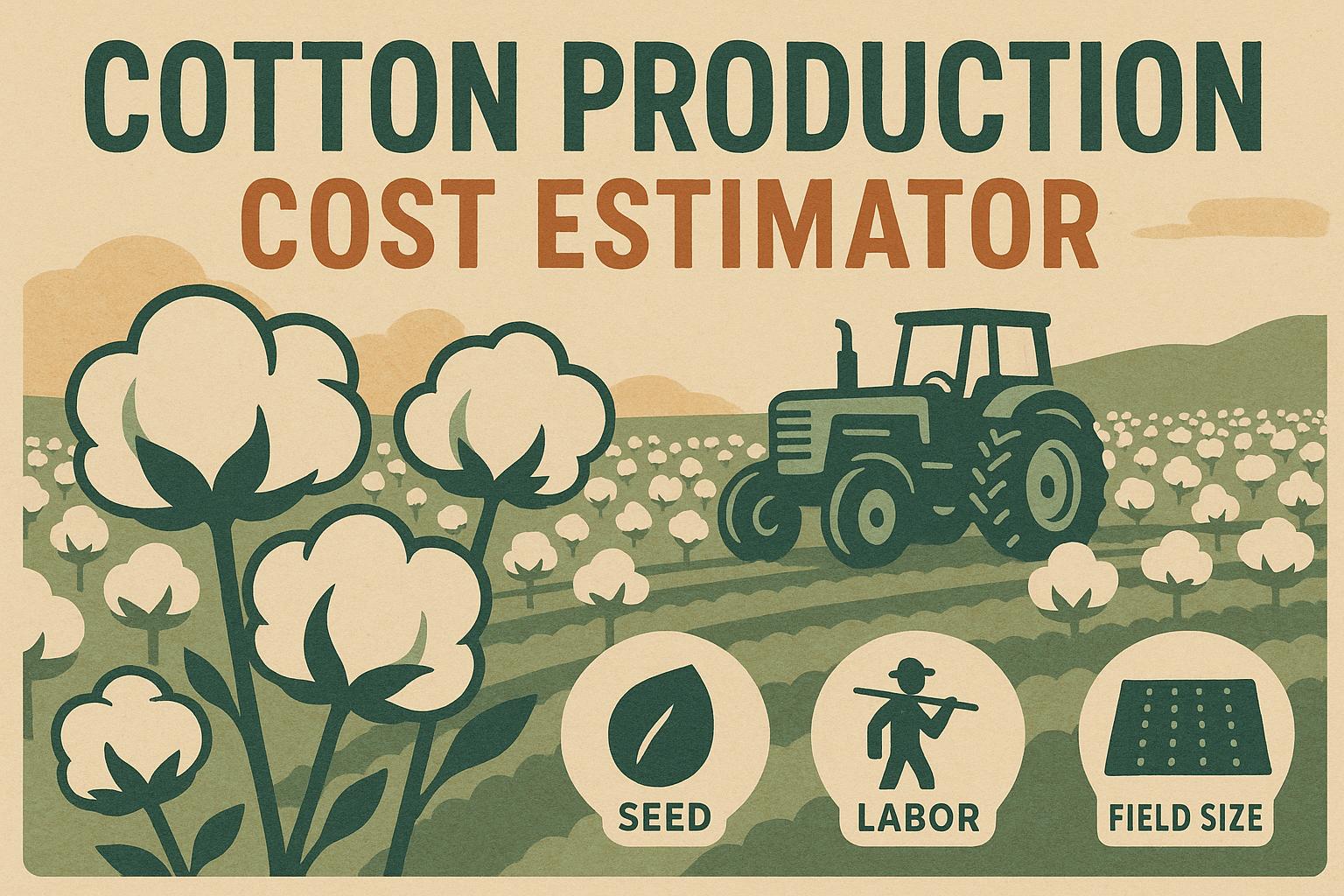Cotton heat stress management is a critical concern for growers facing increasingly erratic weather patterns across the Belt, where prolonged high temperatures can slash boll retention and fiber quality, potentially reducing yields by 15-30% in vulnerable fields. For veteran producers accustomed to scouting for thresholds and adjusting inputs mid-season, effective cotton heat stress management strategies can mitigate these risks, preserving micronaire and staple length while optimizing resource use. Unlike cooler climates where heat is sporadic, regions like the arid Southwest or humid Southeast demand proactive approaches to maintain 1,200-1,600 pounds per acre. This guide delves into advanced cotton heat stress management techniques, from variety selection to irrigation tweaks, drawing on extension trials and field data to equip seasoned farmers with tools for resilient production. Link to our irrigation strategies post for integrated water management insights.
Understanding Heat Stress Impacts on Cotton Physiology
Cotton heat stress management begins with recognizing how elevated temperatures disrupt plant processes, particularly during squaring and boll fill when daytime highs exceed 95°F and nights stay above 75°F. At these levels, pollen viability drops, leading to aborted squares and reduced boll set, as enzymes for starch synthesis falter. Extension data indicates that for every degree above optimal (86-95°F daytime), yield potential declines by 1-2%, compounded by accelerated maturity that shortens fiber elongation.
In sandy soils with low water-holding capacity, heat exacerbates drought stress, promoting oxidative damage and leaf senescence. Clay-heavy fields, while retentive, can amplify root zone heat, inhibiting nutrient uptake like potassium, essential for osmotic regulation. For experienced growers, monitoring canopy temperature via infrared thermometers (target differential <5°F from air) reveals early stress before visible wilt, allowing timely interventions. Factor in humidity; high dew points in the Mid-South intensify heat index, mimicking desert conditions despite adequate moisture.
Varietal tolerance varies—upland cottons with deeper roots withstand better than shallow-rooted types. Historical trials show heat-tolerant lines maintain 10-15% higher boll loads under stress. These insights underscore why cotton heat stress management must integrate agronomic and genetic approaches for sustainable yields.
Selecting Heat-Tolerant Cotton Varieties
Choosing resilient varieties is foundational to cotton heat stress management, prioritizing traits like robust rooting and efficient stomatal regulation to minimize transpiration losses. Extension evaluations highlight hybrids with Bt and herbicide tolerance that also exhibit heat resilience, sustaining boll development at 100°F+.
Key selection criteria include heat unit accumulation; varieties requiring fewer degree-days (DD60s) mature faster, escaping peak summer heat. For Southwest drylands, opt for indeterminates with high first-position retention, reducing compensatory growth demands. Southeast growers benefit from storm-proof bolls that resist shedding under humid heat.
Field trials demonstrate 5-10% yield advantages for heat-adapted varieties in stress-prone years. Incorporate micronaire stability—aim for 3.5-4.9 to avoid discounts. When scouting seed catalogs, cross-reference with regional performance data; for instance, Delta varieties excel in humid heat due to enhanced cuticular wax. This targeted approach in cotton heat stress management bolsters baseline resilience before environmental pressures mount.
Optimizing Planting Dates and Density for Heat Mitigation
Strategic planting windows are pivotal in cotton heat stress management, aligning reproductive stages with milder periods to evade July-August extremes. In the Southwest, early planting (mid-April) advances flowering before monsoons, but delays (early May) suit the Southeast to dodge cool springs that delay emergence.
Density adjustments modulate canopy microclimates; 80,000-100,000 plants per acre foster closure, shading soil to lower radiant heat by 5-10°F. In high-heat zones, reduce to 60,000 for better airflow, curbing humidity buildup that amplifies stress. Skip-row configurations in drylands enhance ventilation, cutting evapotranspiration by 10%.
Soil prep influences heat; minimum tillage retains residue mulch, cooling surface temperatures by 3-5°F. Pre-plant incorporation of amendments like gypsum improves structure, aiding root exploration for deeper moisture. These tactics in cotton heat stress management preempt vulnerabilities, sustaining vegetative vigor into fruiting.
Advanced Irrigation Scheduling to Combat Heat Stress
Irrigation is a cornerstone of cotton heat stress management, replenishing deficits to maintain turgor and cooling via transpiration. Pivot systems with VRI adapt to field variability, applying 0.5-1 inch in sandy zones versus clays, guided by ET models (0.2-0.3 inches daily peak).
Soil sensors at 6-24 inches monitor volumetric water content, triggering at 50% depletion to prevent wilting. Integrate weather stations for predictive scheduling, factoring humidity to avoid over-watering that promotes boll rot. Deficit strategies during non-critical phases conserve 15-20% water while hardening plants.
Drip irrigation excels in precision, delivering subsurface moisture to minimize evaporation losses by 25%. Fertigate potassium (20-40 lbs/acre) during heat waves for enhanced tolerance. These data-driven methods in cotton heat stress management optimize WUE to 0.25-0.3 lbs lint per inch, safeguarding yields.
Nutrient Management Tailored for Heat Resilience
Balanced fertility fortifies cotton heat stress management, emphasizing potassium for membrane stability and osmotic adjustment under thermal duress. Soil tests target 150-200 ppm K, with foliar applications (5-10 lbs/acre) during squaring to bolster uptake.
Nitrogen moderation prevents lush growth prone to heat-induced lodging; split applications (100-150 lbs total) align with demand, avoiding excesses that heighten susceptibility. Phosphorus aids rooting, with banded starters enhancing early vigor against spring heat.
Micronutrients like zinc (5-10 lbs/acre) mitigate oxidative stress, per trial data showing 5% yield preservation. Timing is key—pre-bloom boosts for reproductive tolerance. These targeted inputs in cotton heat stress management sustain metabolic functions, minimizing boll shed.
Cultural Practices: Cover Crops and Mulching for Soil Cooling
Incorporating covers and mulches enhances cotton heat stress management by moderating soil temperatures and conserving moisture. Winter rye residues, terminated pre-plant, provide mulch that lowers peak soil heat by 4-6°F, per studies.
Legume covers like clover add nitrogen while improving tilth for better root cooling. In no-till systems, residues reduce evaporation by 20%, extending irrigation intervals. Plastic mulches in early plantings accelerate warming but switch to organic for summer reflection.
Row orientation—east-west maximizes shading in high-sun areas, cutting canopy heat by 2-3°F. These low-input tactics in cotton heat stress management foster microclimates conducive to sustained growth.
Monitoring and Scouting: Early Detection Tools
Vigilant monitoring underpins cotton heat stress management, employing tech like drones for NDVI mapping to spot stressed zones early. Infrared guns assess leaf temperatures, alerting at >5°F above ambient.
Apps integrate ET data with thresholds, predicting stress 2-3 days ahead. Weekly scouting evaluates boll load and vigor, adjusting for varietal baselines. Soil probes track moisture gradients, preventing hidden deficits.
These proactive tools in cotton heat stress management enable timely responses, averting 10-20% losses.
Chemical Aids: PGRs and Antitranspirants for Stress Alleviation
Plant growth regulators (PGRs) like mepiquat refine cotton heat stress management by compacting canopies for better heat dissipation. Applications at matchhead square (0.5-1 oz/acre) curb vegetative excess, enhancing boll set by 5-10%.
Antitranspirants form films reducing water loss by 15%, applied pre-heat wave. Foliar antioxidants mitigate cellular damage. Trials confirm 8-12% yield protection.
Judicious use in cotton heat stress management complements agronomics, avoiding over-reliance.
Integrated Approaches: Combining Tactics for Maximum Resilience
Holistic cotton heat stress management integrates varieties, irrigation, and monitoring for compounded benefits. For example, VRI with heat-tolerant hybrids sustains yields at 90% potential under stress.
Rotations with covers build organic matter, buffering heat. Data platforms synthesize inputs for zone-specific plans.
This synergy in cotton heat stress management yields resilient systems, adapting to variability.
Economic Considerations: ROI of Heat Stress Mitigation
Investing in cotton heat stress management pays dividends; VRI recoups via 15% water savings, equating $50-100/acre. Tolerant varieties add $20-40/acre in premiums.
Monitoring tools avert losses worth 200-300 lbs/acre. Budget models project 2-3 year payback.
Prioritize per local risks for optimal ROI in cotton heat stress management.
| Strategy | Cost Estimate | Benefits | Yield Impact |
|---|---|---|---|
| Heat-Tolerant Varieties | $20-30/acre seed premium | Enhanced boll retention | +5-10% |
| VRI Irrigation | $500-1,000/acre install | Water efficiency | Stable under stress |
| PGR Applications | $10-15/acre | Canopy control | +5-8% |
| Monitoring Tools | $0.50-1/acre | Early intervention | +10-15% |
Adapt for regional economics.
Overcoming Common Challenges in Heat Stress Management
Barriers like variable forecasts resolve with ensemble models. Input costs? Prioritize high-ROI tactics. Equipment access? Cooperatives share resources.
These solutions ensure effective cotton heat stress management.
Future Innovations: Emerging Tech for Heat Resilience
Genomics promises ultra-tolerant varieties. AI predicts microclimates. Nano-materials enhance antitranspirants.
These advancements elevate cotton heat stress management.
In summary, robust cotton heat stress management safeguards profitability. Select tolerant varieties, optimize irrigation, monitor vigilantly, and integrate tactics. Track metrics annually.


